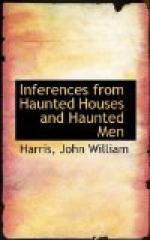[Footnote 1: Podmores “Studies,” p. 228.]
To connect apparitions with hypnotism.
In their case, and in so-called spiritual experiences (spiritistic is the better word), there is generally a preceding feeling like entering an icehouse.[2] This is described as occurring to the butler of the Haunted House at B——, Harold Sanders, in 1896; to Mr. “Endell,” and to others. This chill is surely identical with, or very closely related to, the chill of hypnotism mentioned by Binet and Fere.[3] The balance of the circulation has been interfered with. They state that this is the only symptom by which any one can tell he has been hypnotised, and that this is not always present.
[Footnote 2: “Alleged Haunting,” &c., pp. 50, 139.]
[Footnote 3: “Animal Magnetism,” chap. xiv.]
In continuous slight hypnotism, chills on part of the scalp, part of the shoulder, part of the face, or the ribs, etc., may be experienced; they are possibly signs of slackening hypnotic power.
There is another symptom, hyperaesthesia of the eye, which Binet and Fere omit; this is extremely rare among men, and with women results from local affection. The symptom probably appears in hypnotic cases from the cutaneous lesser sciatic nerve, which is connected with the nerves of the sexual system, being affected.
The chill and the hyperaesthesia of the eyes can be so severe that a doctor or an oculist would be consulted.
The feeling of gravel in the eye is probably produced by light falling through chinks on the eye when hyperaesthetic during sleep—the lids may be slightly tightened, as it were; this is perhaps a nearer approach to a profounder hypnotism.
“During actual hypnosis,” says Mr. Harry Vincent, “frequently the contraction of the muscles is so obvious that the subject appears to be indulging in a grim smile."[4]
[Footnote 4: “Elements of Hypnotism,” p. 99.]
I venture to call attention to the grim smile worn by Charles Kingsley in the portrait which prefaces the large edition of his Life and Letters. Charles Kingsley suffered from frequent fits of exhaustion; these are often the results of excessive hypnotism after the limit (at the fifth or sixth effort) of the hypnotist’s power has been reached. His brother Henry, we learn from Mr. Kegan Paul’s “Memoirs,” was excessively hypnotisable. His character was weaker perhaps than Charles’s, but the geniality of his writings bears testimony to his remarkable ability.
He was only rescued from a condition little better than a tramp’s by a kind friend. Charles’s life was perhaps shortened by hypnotism. One of Kingsley’s neighbours at Eversley was the late Sir W. Cope. The elder son of this gentleman, when Secretary of Legation at Stockholm, came to a tragic end. He suddenly, when out walking with a friend, although his health had been apparently perfect, began to shout and wave his umbrella. He was put under the care of attendants, as he was considered to be temporarily insane. He jumped out of a window and was killed. Voices insulting or threatening him, and with such scoundrels speech would be of something dreadful, would provoke or frighten the unhappy man.




